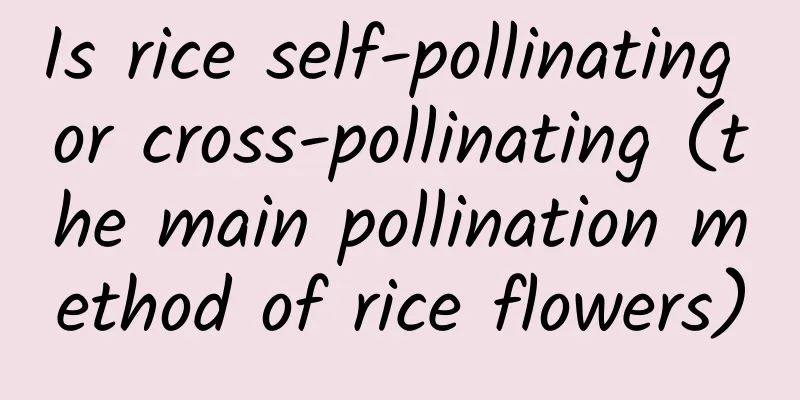Is rice self-pollinating or cross-pollinating (the main pollination method of rice flowers)

The main pollination method of rice flowersRice is self-pollinating. They are hermaphroditic, and the pollen from the stamens is transferred to the pistils, which means that wild rice is pure rice. However, Academician Yuan Longping discovered a natural hybrid rice on the farm, which means that there are individuals with sterile stamens in nature. Only in this way can the pollen from other stamens pollinate the pistil. The rice we grow now is all self-pollinating . During pollination, the anthers on the stamens fall onto the female pollen , combine with the ovules in the female pollen's ovary, develop into embryos, and finally become the rice we eat. Under normal circumstances, rice begins to bloom, pollinate and bear fruit after entering the flowering period, which takes about a month. The growth process of riceThe growth process of rice can be generally divided into two stages: vegetative growth and reproductive growth. It has to go through seed soaking, germination, sowing, seedling stage, transplanting, greening stage, tillering stage, panicle differentiation stage, heading and flowering stage, grain filling stage, and maturity stage. Seed SoakingFrom early May to mid-May, air the seeds for three days before soaking. Airing can sterilize and activate the activity of seeds. After sun exposure, soak them in 1000 times diluted 50% carbendazim wettable powder. Generally, soak for 48 hours at 20 degrees and 24 hours at 30 degrees. GerminationTake out the seeds that have absorbed enough water, put them in a snakeskin bag for germination. Generally, after 48 hours, all the seeds will break open and show white color. sowingSow the germinated seeds into the seedling field. Keep the soil moist at this time. Two days later, the seedlings will break through the soil and the seedling field will turn green. Seedling stageOne week after sowing, the seedlings will grow their first leaf; 10 days later, when the seedlings have one leaf and one heart, weaning fertilizer should be applied. 20 days later, when the seedlings have four leaves and one heart, tillering fertilizer should be applied. 30 days later, when the seedlings have six leaves and one heart, they can be transplanted to the field and "wedding fertilizer" should be applied. TransplantingIn mid-June, the seedlings are transplanted and planted at a reasonable density. Then enough basic seedlings are planted to promote effective tillering and ensure high yield and effective ears. At this time, shallow water is mainly used to protect the seedlings in the field. Green periodDuring transplanting, the root system is damaged by pulling out the seedlings, and it takes 5 to 7 days for the root system to sprout new roots and the aboveground part to resume growth. This period is called the greening period, during which the field should be kept deep watered and greening fertilizer should be applied. Tillering stageIn mid-to-late June, rice enters the early tillering stage after turning green. In early July, rice enters the peak tillering stage. This period of time is about 10 days, which is called the effective tillering period. In late July, effective tillering is basically completed. The tillers during this period cannot produce heading and fruit, which is called the ineffective tillering period. At this time, the field should be drained and sun-dried to control ineffective tillering. The ineffective tillering period is about 20 days. Jointing and Booting StageThe jointing and heading stage refers to the period from the beginning of panicle differentiation to the growth of panicles, which generally takes about a month. In early August, rice begins to joint and heading, transitioning from the vegetative growth period to the reproductive growth period. At this time, the field should maintain a shallow water layer. Heading and flowering periodIn early September, rice begins to head. Three to five days later, a large area of rice begins to head. Seven days later, rice enters the early flowering stage. Three to five days later, rice enters the peak flowering stage. During this period, a shallow water layer should be maintained in the field. Grouting and fruiting periodIn mid-September, rice begins to fill with grain, and irrigation is required intermittently to maintain root vitality and water requirements during the filling period. In late September, the husk becomes hard and yellow, and the rice ears begin to droop. MaturityIn early October, rice enters the maturity stage. At this time, the stalks are green, the seeds are yellow, the husks are hard and golden, and the grains are full, and it is time to harvest. |
Recommend
How to grow potted mint
Breeding Instructions Soil For the cultivation of...
When to water garlic
1. Coated water Garlic is usually sown in autumn....
Is it good to grow peach blossoms at home? How to grow potted peach blossoms
1. Is it good to keep it at home? Peach blossoms ...
How to repot Amaryllis
Repotting and soil changing of Amaryllis Amarylli...
Introduction to the famous variants of Venus flytrap
Baron Flytrap The Baron Venus Flytrap is a specie...
Key points of high-yield potato cultivation technology
Potatoes generally prefer cool climatic condition...
How to fertilize forsythia
Fertilization method Forsythia requires a relativ...
Why is the fortune tree called the fortune tree? Pictures of the fortune tree
1. Promote sales The money tree was originally ca...
Is the flower of Ba La Xiang poisonous?
1. Is it poisonous? The flowers of the baicalensi...
When is millet harvested?
Millet is native to the Yellow River Basin in Chi...
How to grow a small bonsai welcoming pine
1. Breeding methods 1. Flower soil: To grow the W...
How long does gardenia bloom? How to care for it after flowering?
Gardenia is a famous traditional flower in China....
Where to place lucky bamboo for good feng shui
1. The wealth position in the home You can tell i...
The Difference Between Abelmoschus Altissima and Okra
1. Differences in plants The height of hibiscus i...
"Flower Growing Video" Good Luck
Video on how to breed the lucky worm How to maint...









